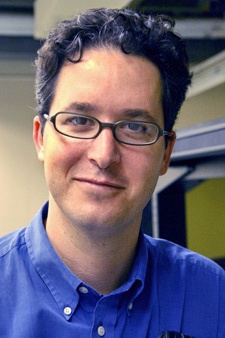Jun 28 2008
Potential risks from the use of nanomaterials will be explored by three Arizona State University engineering faculty in a project supported by a $400,000 grant from the U.S.Department of Energy Office of Biological and Environmental Research.
 Jonathan Posner, assistant engineering professor, is one of three ASU researchers working to see if the nanomaterials that are prevalent in everyday life are detrimental to humans.
Jonathan Posner, assistant engineering professor, is one of three ASU researchers working to see if the nanomaterials that are prevalent in everyday life are detrimental to humans.
Nanomaterials are becoming more prevalent in our lives each day. These are particles of less than 100 nanometers – less than one one-thousandth the width of a human hair – composed of metals, carbon, polymers or semiconductors. They are increasingly used in clothes and cosmetics, plastics and cleaning solutions, skin lotions and bandages.
Nanoparticles offer an array of benefits. They have been found to effectively improve methods of cleaning up water pollution. They are helping produce medical advances by acting as carriers of medicinal drugs to specific parts of the body for fighting cancer. They are used to strengthen plastics and rubber, to make clothing more durable, sunscreen lotions more protective and antibacterial solutions more potent.
But while the properties of nanoscale materials can improve such products, there’s growing concern about the impact of some nanoparticles when they find their way inside our bodies or out into the environment.
“We are exposed to engineered nanomaterials through our skin, eyes, nose and mouth. They get transported into waterways and soils. And we are just not certain if they are detrimental in any way,” explains Jonathan Posner, an assistant professor in Department of Mechanical and Aerospace Engineering and the Department of Chemical Engineering in ASU’s Ira A. Fulton School of Engineering.
Posner’s partners in the research project are Paul Westerhoff, professor and chair of the Department of Civil and Environmental Engineering, and Trevor Thornton, professor in the Department of Electrical Engineering.
They will examine how and where nanomaterials get transported and what environmental and biological risks the materials may pose.
“This research will provide government and industry policy makers essential information to arrive at prudent decisions about the safest ways to regulate, handle, dispose of and manage nanoscale materials in the environment, as well as the potential for using nanomaterials in medical therapies,” Posner says. “To the best of our knowledge, there is no research currently addressing these specific issues.”
The effort will require gaining an understanding of how nanomaterials are partitioned, or separated, particularly in liquids, and how to precisely measure the partitioning and model the process.
For an analogy of this type of partitioning, Posner says, think of salad dressing.
“If you shake up Italian salad dressing, you mix together oil and water and spices. But if you let the dressing sit a while, the oil and water separate into phases. The oil moves to the top and the water to the bottom because they are immiscible [incapable of being mixed] and have different densities. So then where do the spices go?” he says.
“A question like that is important when considering the fate and transport of nanomaterials in the environment and the human body. Partitioning is basically a measure of where the spices go – into the oil or the water,” Posner explains.
“For instance, partitioning determines where nanomaterials end up in the body, such as in the in the blood, kidneys, brain or in fat tissue,” he says. “In the environment, one would be concerned with what fraction of the nanomaterials ends up in the waterways, soils or biomass. Partitioning measurements are typically made for pesticides and pharmaceuticals before they are mass produced, so that we can better understand where they end up.”
Thus with the rising use of nanomaterials, he says, “We need to be able to predict their fate, to know how they might break up and how and where they get transported.”
There are particular questions about the interaction of nanoparticles with human body cells. Some particles may tend to gather on the protective membranes that wrap around the body’s cells. There is concern that the particles could weaken the membrane, causing it, in effect, to leak and harm or even kill cells. It is also not well understood how, or if, nanoparticles enter cells.
Studies of such possible effects have so far been largely inconclusive and sometimes contradictory, Posner says.
The ASU research project is designed to overcome that problem by devising methods to more closely determine the behavior of nanoparticles. That includes developing microfluidic technologies to measure partitioning, transport and toxicity.
Nanoparticle partitioning experiments will provide a foundation for developing screening tests for environmental toxicology and for predicting the behavior of the particles in the environment and the human body.
The project reflects the complexity of trying to grasp the environmental impact of nanotechnology, says Thornton, who also directs the Center for Solid State Electronics Research at ASU.
“This work combines faculty and student research assistants from three areas of engineering – electrical, civil and mechanical,” he says. “It exemplifies the interdisciplinary knowledge necessary to understand nanotechnology and the kind of collaborative approach to research that is taking place at ASU.”
The project, Posner adds, “will build on the very strong nanotechnology research already going on at ASU.”
A wide range of nanotechnology research includes projects funded by the Environmental Protection Agency focusing on the toxicology of nanomaterials as well as on using nanomaterials to treat water.